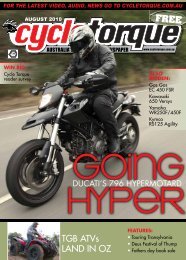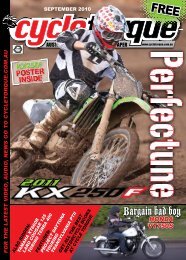CAN-AM SPYDER RT - Cycle Torque
CAN-AM SPYDER RT - Cycle Torque
CAN-AM SPYDER RT - Cycle Torque
Create successful ePaper yourself
Turn your PDF publications into a flip-book with our unique Google optimized e-Paper software.
QUAD feature<br />
Play horse<br />
TesT & phoTos By Chris piCkeTT<br />
ARCTIC Cat’s 1000cc recreational<br />
aTV boasts the biggest and most<br />
powerful engine in its class. if you<br />
want to experience the power for an<br />
adrenaline hit, no problem, it will<br />
blur the scenery quick smart. But if<br />
you need to mend the odd fence or<br />
two, or feed the cows, the Thundercat<br />
has you covered there as well.<br />
Powertrain and suspension<br />
As the engine component of this ATV<br />
is at the forefront of its promotional<br />
literature we might as well start there.<br />
A 951cc liquid-cooled and fuel injected<br />
V-twin engine powers the Thundercat<br />
H2. Arctic Cat doesn’t quote any power<br />
figures but there is plenty on tap, that’s<br />
for sure. At idle it feels very lumpy,<br />
like it’s raring to go. Revs build quickly<br />
as you give the thumb throttle a quick<br />
hit. Instantly you are aware this will be<br />
an exciting ride.<br />
Transferring power to the ground is<br />
the Duramatic automatic transmission,<br />
which uses a centrifugal clutch and<br />
primary and belt-driven clutches to<br />
harness the grunt. Arctic Cat says the<br />
constant engagement extends belt<br />
life and also makes for better engine<br />
braking. There’s also a rear differential<br />
spike load damper which allows the<br />
transmission to deliver maximum<br />
power to the tyres without driveline<br />
wear. In essence this is a clutch<br />
work or play.<br />
Arctic Cat’s Thundercat<br />
is happy doing either.<br />
system which slips if you have a<br />
sharp increase in torque from a heavy<br />
landing or impact, which in turn helps<br />
protect the drive-line from damage.<br />
A switch on the right handlebar<br />
allows you to select between<br />
2WD/4WD/differential lock. High<br />
and low ranges are also available via<br />
an easily accessible hand lever just in<br />
front of the rider’s left knee.<br />
250mm of suspension travel (preload<br />
adjustable) will soak up most hits, and<br />
275mm of ground clearance will let you<br />
get over most obstacles. For 2010 Arctic<br />
Cat has lengthened the wheelbase by<br />
50mm in an attempt to harness the<br />
power of the Thundercat.<br />
on the farm<br />
The thing we like about the<br />
Thundercat is its ability to work and<br />
play hard. This thing gets up and<br />
boogies, make no mistake about that.<br />
If you want to ride like a larrikin the<br />
Thundercat will let you carve up the<br />
paddock or jump logs like no-one’s<br />
business. But if you need to carry hay<br />
or drag a trailer full of fence posts<br />
through the mud the Thundercat can<br />
accommodate you too.<br />
In 2WD the big cat is a ball of<br />
fun. Tail out action is pretty much<br />
instantaneous. If you start hitting<br />
rocks and erosion banks at speed<br />
the Thundercat starts to show the<br />
workhorse in its design. In other words<br />
the ATV is aimed more so at the farmer<br />
who likes a bit of fun rather than the<br />
sporting ATV rider. Arctic Cat actually<br />
has a competition ATV called the<br />
Mudpro. It looks very similar to the<br />
Thundercat but does have a couple of<br />
styling touches to let you know which<br />
one’s which.<br />
In 4WD mode you can go most<br />
places. Our test farm had been deluged<br />
by rain and was very wet in places.<br />
Even muddy uphill sections were<br />
dispatched with ease in 4WD, while<br />
2WD struggled at times, especially<br />
with the power at hand. Get throttle<br />
happy and the rear wheels would spin<br />
easily. One method of countering this<br />
was to be very on/off the throttle to<br />
get traction. But it didn’t matter really,<br />
just flick the 4WD switch and presto,<br />
instant traction. Although we didn’t<br />
really need it we did lock the diff to<br />
see what the difference was. On one<br />
particularly slippery section – one we<br />
wouldn’t normally tackle in such wet<br />
weather – the diff lock got us up where<br />
you would normally struggle.<br />
If you want sideways action you’ll<br />
need to keep it in 2WD. One downside<br />
with 4WD is a larger turning circle but<br />
it’s horses for courses; sometimes you<br />
38 - APRIL 2010 Rear rack is huge, and there’s a similar one at the front. Engine is tucked away.<br />
APRIL 2010 - 39





